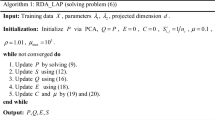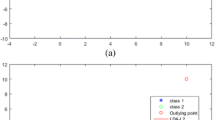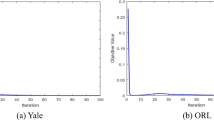Abstract
Recently, sparse representation models have attracted considerable interests in the field of feature extraction. In this paper, we propose a novel supervised feature extraction method called sparsity regularization discriminant projection (SRDP), which aims to preserve the sparse representation structure of the data and simultaneously maximize the ratio of nonlocal scatter to local scatter. More specifically, SRDP first constructs a concatenated dictionary through the class-wise principal component analysis decompositions. Second, the sparse representation structure of each sample is quickly learned with the constructed dictionary by matrix–vector multiplications. Then SRDP regards the learned sparse representation structure as an additional regularization term of unsupervised discriminant projection so as to construct a new discriminant function. Finally, SRDP is transformed into a generalized eigenvalue problem. Experimental results on five representative image databases demonstrate the effectiveness of our proposed method.









Similar content being viewed by others
References
Wang Z, Yang W, Shen F (2016) Face recognition using a low rank representation based projections method. Adv Space Res 43(3):823–835
Yuan S, Mao X, Chen L (2017) Multilinear spatial discriminant analysis for dimensionality reduction. IEEE Trans Image Process 26(6):2669–2681
Nie F, Xiang S, Song Y, Zhang C (2009) Orthogonal locality minimizing globality maximizing projections for feature extraction. Opt Eng 48(1):017202
Turk Matthew, Pentland Alex (1991) Eigenfaces for recognition. J Cogn Neurosci 3(1):71–86
Belhumeur PN, Hespanha JP, Kriegman DJ (1997) Eigenfaces versus fisherfaces: recognition using class specific linear projection. IEEE Trans Pattern Anal Mach Intell 19(7):711–720
Gao Q, Liu J, Zhang H et al (2012) Enhanced fisher discriminant criterion for image recognition. Pattern Recogn 45(10):3717–3724
Li H, Jiang T, Zhang K (2006) Efficient and robust feature extraction by maximum margin criterion. IEEE Trans Neural Netw 17(1):157–165
Wang G, Shi N, Shu Y et al (2016) Embedded manifold-based kernel Fisher discriminant analysis for face recognition. Neural Process Lett 43(1):1–16
Lu GF, Zou J, Wang Y (2016) A new and fast implementation of orthogonal LDA algorithm and its incremental extension. Neural Process Lett 43(3):687–707
Roweis ST, Saul LK (2000) Nonlinear dimensionality reduction by locally linear embedding. Science 290(5500):2323–2326
Tenenbaum JB, De Silva V, Langford JC (2000) A global geometric framework for nonlinear dimensionality reduction. Science 290(5500):2319–2323
Belkin M, Niyogi P (2003) Laplacian eigenmaps for dimensionality reduction and data representation. Neural Comput 15(6):1373–1396
Bengio Y, Paiement JF, Vincent P et al (2004) Out-of-sample extensions for lle, isomap, mds, eigenmaps, and spectral clustering. Adv Neural Inf Process Syst 16:177–184
He X, Yan S, Hu Y et al (2005) Face recognition using Laplacianfaces. IEEE Trans Pattern Anal Mach Intell 27(3):328–340
He X, Cai D,Yan S et al (2005) Neighborhood preserving embedding[C]//Computer Vision, 2005. In: ICCV 2005. Tenth IEEE international conference on IEEE, vol 2, pp 1208–1213
Wang X, Liu Y, Nie F, Huang H (2015) Discriminative unsupervised dimensionality reduction. In: IJCAI, pp 3925–3931
Yan S, Xu D, Zhang B et al (2007) Graph embedding and extensions: a general framework for dimensionality reduction. IEEE Trans Pattern Anal Mach Intell 29(1):40–51
Nie F, Xu D, Tsang IWH, Zhang C (2010) Flexible manifold embedding: a framework for semi-supervised and unsupervised dimension reduction. IEEE Trans Image Process 19(7):1921–1932
Wang R, Nie F, Hong R, Chang X, Yang X, Yu W (2017) Fast and orthogonal locality preserving projections for dimensionality reduction. IEEE Trans Image Process 26(10):5019–5030
Wang R, Nie F, Yang X, Gao F, Yao M (2015) Robust 2DPCA with non-greedy L1-norm maximization for image analysis. IEEE Trans Cybern 45(5):1108–1112
Yang J, Zhang D, Yang J et al (2007) Globally maximizing, locally minimizing: unsupervised discriminant projection with applications to face and palm biometrics. IEEE Trans Pattern Anal Mach Intell 29(4):650–664
Nie F, Shiming X, Changshui Z (2007) Neighborhood MinMax Projections. In: IJCAI
Zhang D, He J, Zhao Y et al (2014) Global plus local: a complete framework for feature extraction and recognition. Pattern Recogn 47(3):1433–1442
Gao Q, Liu J, Zhang H et al (2013) Joint global and local structure discriminant analysis. IEEE Trans Inf Forensics Secur 8(4):626–635
Zang F, Zhang J, Pan J (2012) Face recognition using elasticfaces. Pattern Recogn 45(11):3866–3876
Luo T, Hou C, Yi D et al (2016) Discriminative orthogonal elastic preserving projections for classification. Neurocomputing 179:54–68
Yuan S, Mao X (2018) Exponential elastic preserving projections for facial expression recognition. Neurocomputing 275:711–724
Shojaeilangari S, Yau WY, Nandakumar K et al (2015) Robust representation and recognition of facial emotions using extreme sparse learning. IEEE Trans Image Process 24(7):2140–2152
Zhang X, Pham DS, Venkatesh S et al (2015) Mixed-norm sparse representation for multi view face recognition. Pattern Recogn 48(9):2935–2946
Liu Z, Pu J, Xu M et al (2015) Face recognition via weighted two phase test sample sparse representation. Neural Process Lett 41(1):43–53
Qiao L, Chen S, Tan X (2010) Sparsity preserving projections with applications to face recognition. Pattern Recogn 43(1):331–341
Gui J, Sun Z, Jia W et al (2012) Discriminant sparse neighborhood preserving embedding for face recognition. Pattern Recogn 45(8):2884–2893
Lei YK, Han H, Hao X (2015) Discriminant sparse local spline embedding with application to face recognition. Knowl Based Syst 89:47–55
Yin F, Jiao LC, Shang F et al (2014) Sparse regularization discriminant analysis for face recognition. Neurocomputing 128:341–362
Nie F, Huang H, Cai X, Ding CH (2010) Efficient and robust feature selection via joint L2, 1-norms minimization. In: Advances in neural information processing systems, pp 1813–1821
Nie F, Wang H, Deng C, Gao X, Li X, Huang H (2016) New L1-norm relaxations and optimizations for graph clustering. In: AAAI, pp 1962–1968
Deng C, Lv Z, Liu W, Huang J, Tao D, Gao X (2015) Multi-view matrix decomposition: a new scheme for exploring discriminative information. In: IJCAI, pp 3438–3444
Nie F, Wang X, Huang H (2014) Clustering and projected clustering with adaptive neighbors. In: Proceedings of the 20th ACM SIGKDD international conference on knowledge discovery and data mining. ACM, pp 977–986
The Olivetti & Oracle Research Laboratory Face Database of Faces. http://www.cam-orl.co.uk/facedatabase.html
Sim T, Baker S, Bsat M (2002) The CMU pose, illumination, and expression (PIE) database[C]//Automatic Face and Gesture Recognition, 2002. In: Proceedings of the fifth IEEE international conference on IEEE, pp 46–51
Phillips PJ, Wechsler H, Huang J et al (1998) The FERET database and evaluation procedure for face-recognition algorithms. Image Vis Comput 16(5):295–306
Huang GB et al (2007) Labeled faces in the wild: A database for studying face recognition in unconstrained environments. Vol. 1. No. 2. Technical Report 07-49, University of Massachusetts, Amherst
Acknowledgements
The authors would like to thank the anonymous reviewers for their valuable and constructive criticisms that are very helpful to improve the quality of this paper. This work was supported by the National Science Foundation of China (Grant No. 61603013).
Author information
Authors and Affiliations
Corresponding author
Rights and permissions
About this article
Cite this article
Yuan, S., Mao, X. & Chen, L. Sparsity Regularization Discriminant Projection for Feature Extraction. Neural Process Lett 49, 539–553 (2019). https://doi.org/10.1007/s11063-018-9842-4
Published:
Issue Date:
DOI: https://doi.org/10.1007/s11063-018-9842-4




